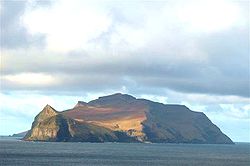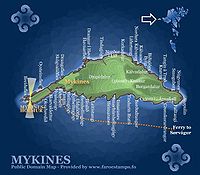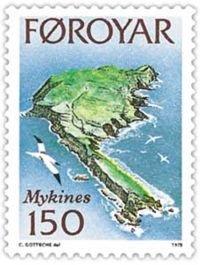- Mykines
-
Mykines — Island — Mykines seen from the east (Sørvágur) in October Location within the Faroe Islands Coordinates: 62°06′N 7°36′W / 62.1°N 7.6°WCoordinates: 62°06′N 7°36′W / 62.1°N 7.6°W State  Kingdom of Denmark
Kingdom of DenmarkConstituent country  Faroe Islands
Faroe IslandsArea – Total 10 km2 (3.9 sq mi) Highest elevation 560 m (1,837 ft) Population – Total 10 – Density 1/km2 (2.6/sq mi) Time zone GMT (UTC+0) – Summer (DST) EST (UTC+1) Calling code 298 Mykines (Danish: Myggenæs) is the western-most of the main 18 islands in the Faroe Islands. See also the only settlement on the island, Mykines.
Only 11 people live in village Mykines all year around. The oldest inhabitant is 75 and the youngest is 6 years old. Altogether there are 40 houses, only 6 are inhabited year-round. Earlier Mykines was one of the biggest villages in the Faroes. For instance, 170 people lived on Mykines in 1940.
Mykines was from 1911 to 2004 its own community but in 2005 was united with Sørvagur kommune. To the west of Mykines is the islet Mykines Holmur. A 40 meter long bridge connects Mykines to the Islet. A lighthouse is on the islet and it was built in 1909. On the northern side of Mykines is the valley Korkadalur, where one can find the great columns of basalt, called the Stone-wood. Mykines is famous for its rich nature and birdlife. A footbridge connects Mykineshólmur with the island of Mykines over a 35 metre deep gorge. The sea stacks surrounding the lighthouse at the far end of the cape are a sight of striking beauty.
Contents
Geography
Furthermore, Mykines is so far west, that it's actually west of 7.5 degrees W, effectively putting it in the UTC-1 region. However, Mykines uses Greenwich Mean Time like the rest of the Faroes.
Geology
Mykines belongs to the eldest part of the Faroe Islands and was formed about 60 million years ago. The Faroese basalt is divided into 3 series of eruption, the lower and eldest, the middle and the upper and youngest, the lower is formed by eruption through long fissures of rather fluent lava, which has formed great flat volcanoes. In the sound between Mykines and Mykines Holm, Holmgjogv, one can see some of the mightiest on the Faroes, with thickness of about 50 meter
The softer volcanic tuff-layers between the basaltic layers is partly eroded, so there, especially on the steep northern side, are some of the richest bird cliffs in the world.
Flora and fauna
Large numbers of puffins and gannets inhabit the island. There are also many birds located on Mykineshólmur, a small islet to the immediate west of Mykines. A footbridge over the 35 m gorge Hólmgjógv links the two islands.
Mountain Hares (Lepus timidus) have been introduced to the island, and inhabit the mountain area and surrounding valleys. The Mykines House Mouse (Mus musculus mykinessiensis) is endemic for Mykines, and this might suggest an early introduction, maybe as early as in the 6th century by the Irish monks, who cultivated this island. Its closest relative was the now extinct St Kilda House Mouse (Mus musculus muralis).
On the rocks at the waters edge there are colonies of cormorants while the eroded tuff layers in the cliffs make perfect shelves for guillemots and razor-billed auks. On the grassy slopes above the bird cliffs, thousands of puffins have their dens, and their strong feces is a powerful fertilizer on the slopes.
History
It has been suggested that the name Mykines is actually pre-Norse in origin, coming from muc-innis, a Celtic term for pig island. This may be a reference to whales, which are known as muc-mhara (Sea sows) in Gaelic.
- 625 - pollen analysis indicates oats and barley were grown on Mykines, possibly by early settlers such as monks and hermits
- 1592 - Peter Claussøn Friis, a Norwegian priest, described the Faroese mouse as a distinct species, and the Mykines mouse as a subgroup having especially long powerful hind legs
- 1595 - (approx) on 25 April, fifty boats were shipwrecked in a sudden storm and all the working men of Mykines lost their lives (estimated 200 to 300 men)
- 1667 - Dutch ship "Walcheren" was wrecked on Mykines and the islanders gained goods from the ship
- 1909 - building of the Lighthouse on Mykines Holm and construction of the first bridge over Holmgjogv, the narrow strait between Mykines and Mykines Holm
- 1928 - radio beacons were installed at Nólsoy and Mykines lighthouses, making radio navigation possible for the first time, and Mykines got a telephone connection to the outside world
- 1942 - in spring British forces completed a radar station on á Ólakletti in Liðarhaugi.
- 1953 - the second bridge over Holm Gjogv was built.
- 1970 - flight from Bergen to Vágar Airport crashed in bad weather on Mykines on September 26. Eight of the 34 passengers lost their lives, and the badly wounded were airlifted away by helicopter. A marble memorial was placed in the Church.
- 1970 - Mykines lighthouse was automated and the last man moved from the Holm, which had been occupied continuously from 1909 by a varying population of up to 22 people (including children).
- 1989 - the third bridge between Mykines and Mykines Holm came into use in June
Population progression
Progression of the population of Mykines since 1769:
Year Population 1769 61 1870 114 1890 154 1925 179 1940 170 2004 11 Noted natives and residents
Sámal Joensen-Mikines 1906-1979, Painter
See also
Further reading
- Christiansen, Hans T., and Björn Sörensen. Mykines discover the Faroe Islands. Stockholm: Informationsgruppen AB, 1988. ISBN 918600476X
External links
- Mykines and Kristianshus Info, pictures, birdpictures and birdvoices
- Photo album
- Faroeislands.dk: Mykines Info and pictures
- Personal Website with 16 aerial photos of Mykines
- TrekEarth.com photo gallery with photos of Mykines Island
- TrekEarth.com photo gallery with photos of Mykinesholmur Island
- Faroese Stamps
Islands of the Faroe Islands  Categories:
Categories:- Islands of the Faroe Islands
Wikimedia Foundation. 2010.





